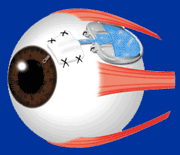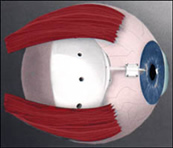 The purpose of glaucoma drainage surgery is to help control the pressure in your eye and preserve your vision. If the intraocular pressure (IOP) remains too high, your optic nerve becomes damaged, leading to vision loss and eventual blindness. Although the long-term success of this procedure is approximately 90%, most patients by 2 years following their surgery still require at least one glaucoma medication in conjunction with their implant for ideal control. (The average patient prior to this surgery is already on 3 or 4 medications and still not adequately controlled; therefore being dependent on fewer medications and having the pressure controlled is a worthwhile trade-off.)
The purpose of glaucoma drainage surgery is to help control the pressure in your eye and preserve your vision. If the intraocular pressure (IOP) remains too high, your optic nerve becomes damaged, leading to vision loss and eventual blindness. Although the long-term success of this procedure is approximately 90%, most patients by 2 years following their surgery still require at least one glaucoma medication in conjunction with their implant for ideal control. (The average patient prior to this surgery is already on 3 or 4 medications and still not adequately controlled; therefore being dependent on fewer medications and having the pressure controlled is a worthwhile trade-off.)
In cases of severe open-angle glaucoma or chronic (long-term) glaucoma, if your eye is at high risk for scarring and your IOP needs to be lowered to preserve your vision, your ophthalmologist (Eye M.D.) may recommend placing a tiny drainage tube in your eye called a seton. This is usually reserved for patients in who a trabeculectomy has failed to achieve adequate glaucoma control but may be used as a primary glaucoma procedure in certain patients such as those who have undergone corneal transplantation. Dr Schertzer usually uses the Ahmed Glaucoma Valve (FP7 & FX1 if single-digit eye pressure is needed.) Another alternative is the Baerveldt Glaucoma Implants (AAO wiki) (Bg 101 350.)
 The drainage tube creates a new channel for fluid to flow from the eye to a filtering area, called a bleb. A tiny plate placed on the eye helps the bleb form and remain open. The tube is covered with a patch and is typically not seen or felt. This procedure is performed in the operating room on an outpatient basis.
The drainage tube creates a new channel for fluid to flow from the eye to a filtering area, called a bleb. A tiny plate placed on the eye helps the bleb form and remain open. The tube is covered with a patch and is typically not seen or felt. This procedure is performed in the operating room on an outpatient basis.
When successful, seton surgery will decrease the pressure in your eye, minimizing the risk of vision loss from glaucoma.
Some of the complications of seton surgery may include:
- failure to control eye pressure with need to resume eye drops short or long-term;
- failure to control eye pressure with the need for repeat surgery;
- eye pressure that is too low;
- irritation or discomfort;
- double vision;
- infection;
- bleeding;
- cataract; and
- erosion of the tube, requiring repeat surgery.
While some people may experience side effects from glaucoma medications or surgery, the risks associated with these side effects should be balanced against the greater risk of leaving glaucoma untreated and losing your vision. There are different ways of dealing with complications, should they occur. These should be discussed with your eye care professional.
(c) 2010 and 2015 Robert M Schertzer, MD, MEd, FRCSC based on 2007 The American Academy of Ophthalmology


